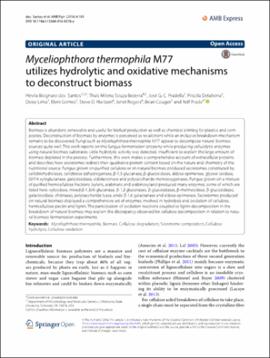| dc.contributor.author | dos Santos, Hevila Brognaro | |
| dc.contributor.author | Bezerra, Thais Milena Souza | |
| dc.contributor.author | Pradella, Jose G. C. | |
| dc.contributor.author | Delabona, Priscila | |
| dc.contributor.author | Lima, Deise | |
| dc.contributor.author | Gomes, Eleni | |
| dc.contributor.author | Hartson, Steve D. | |
| dc.contributor.author | Rogers, Janet | |
| dc.contributor.author | Couger, Brian | |
| dc.contributor.author | Prade, Rolf | |
| dc.date.accessioned | 2018-08-15T12:44:17Z | |
| dc.date.available | 2018-08-15T12:44:17Z | |
| dc.date.issued | 2016-11-02 | |
| dc.identifier | oksd_prade_myceliophthorat_2016 | |
| dc.identifier.citation | dos Santos, H. B., Bezerra, T. M. S., Pradella, J. G. C., Delabona, P., Lima, D., Gomes, E., ... Prade, R. (2016). Myceliophthora thermophila M77 utilizes hydrolytic and oxidative mechanisms to deconstruct biomass. AMB Express, 6, Article 103. https://doi.org/10.1186/s13568-016-0276-y | |
| dc.identifier.uri | https://hdl.handle.net/11244/301402 | |
| dc.description.abstract | Biomass is abundant, renewable and useful for biofuel production as well as chemical priming for plastics and composites. Deconstruction of biomass by enzymes is perceived as recalcitrant while an inclusive breakdown mechanism remains to be discovered. Fungi such as Myceliophthora thermophila M77 appear to decompose natural biomass sources quite well. This work reports on this fungus fermentation property while producing cellulolytic enzymes using natural biomass substrates. Little hydrolytic activity was detected, insufficient to explain the large amount of biomass depleted in the process. Furthermore, this work makes a comprehensive account of extracellular proteins and describes how secretomes redirect their qualitative protein content based on the nature and chemistry of the nutritional source. Fungus grown on purified cellulose or on natural biomass produced secretomes constituted by: cellobiohydrolases, cellobiose dehydrogenase, B-1,3 glucanase, B-glucosidases, aldose epimerase, glyoxal oxidase, GH74 xyloglucanase, galactosidase, aldolactonase and polysaccharide monooxygenases. Fungus grown on a mixture of purified hemicellulose fractions (xylans, arabinans and arabinoxylans) produced many enzymes, some of which are listed here: xylosidase, mixed B-1,3(4) glucanase, B-1,3 glucanases, B-glucosidases, B-mannosidase, B-glucosidases, galactosidase, chitinases, polysaccharide lyase, endo B-1,6 galactanase and aldose epimerase. Secretomes produced on natural biomass displayed a comprehensive set of enzymes involved in hydrolysis and oxidation of cellulose, hemicellulose-pectin and lignin. The participation of oxidation reactions coupled to lignin decomposition in the breakdown of natural biomass may explain the discrepancy observed for cellulose decomposition in relation to natural biomass fermentation experiments. | |
| dc.format | application/pdf | |
| dc.language | en_US | |
| dc.publisher | SpringerOpen | |
| dc.rights | This material has been previously published. In the Oklahoma State University Library's institutional repository this version is made available through the open access principles and the terms of agreement/consent between the author(s) and the publisher. The permission policy on the use, reproduction or distribution of the material falls under fair use for educational, scholarship, and research purposes. Contact Digital Resources and Discovery Services at lib-dls@okstate.edu or 405-744-9161 for further information. | |
| dc.title | Myceliophthora thermophila M77 utilizes hydrolytic and oxidative mechanisms to deconstruct biomass | |
| osu.filename | oksd_prade_myceliophthorat_2016.pdf | |
| dc.description.peerreview | Peer reviewed | |
| dc.identifier.doi | 10.1186/s13568-016-0276-y | |
| dc.description.department | Microbiology and Molecular Genetics | |
| dc.description.department | Biochemistry and Microbiology | |
| dc.type.genre | Article | |
| dc.type.material | Text | |
| dc.subject.keywords | biomass | |
| dc.subject.keywords | cellulose degradation | |
| dc.subject.keywords | cellulose hydrolysis | |
| dc.subject.keywords | cellulose oxidation | |
| dc.subject.keywords | myceliophthora thermophila | |
| dc.subject.keywords | secretome composition | |
